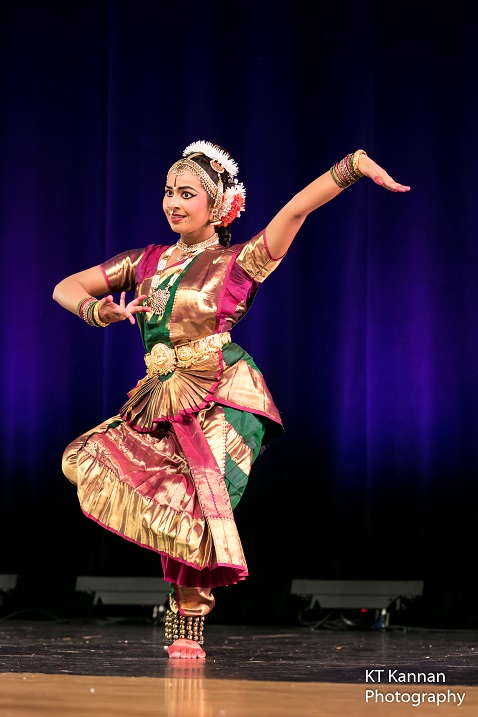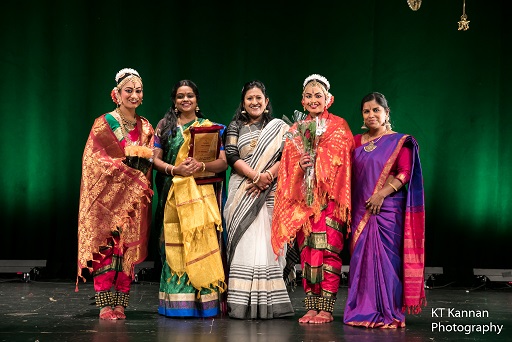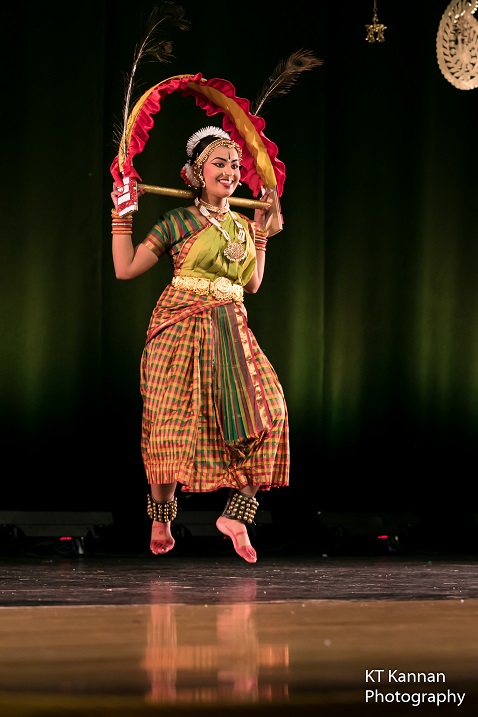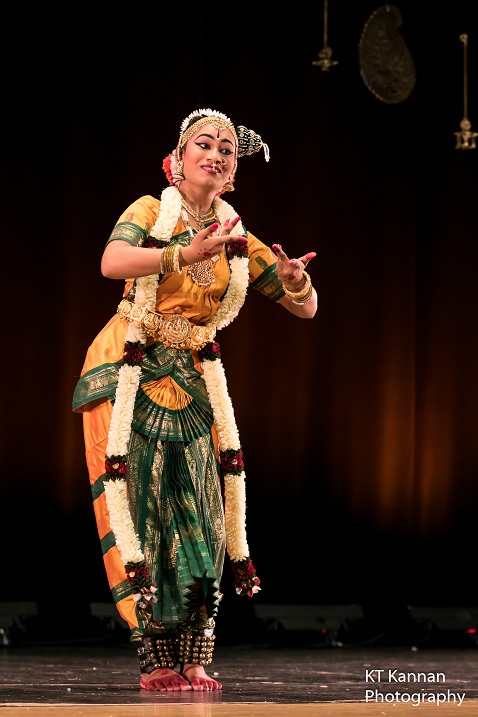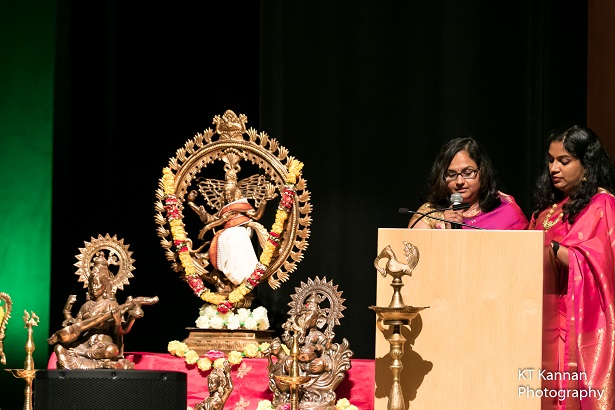Contribute
| Arangetram: Akshitha Balagani And Samika Gangidi |
Neetha Vuppala
08/16/2017
The stage was set in the auditorium of the Grafton High School on Saturday, August 5, 2017 for the Bharatanatyam Arangetram of Akshitha Balagani and Samika Gangidi. 16-year old-Akshitha and 15-year-old Samika are both disciples of Guru Smt. Kalaimangai Anbalagan. Bharatanatyam is a well-known, ancient classical dance form in which bhava, raga and tala are harmoniously expressed. Arangetram is the debut on-stage public performance of a student of dance, following years of training under the guidance of the guru. The Arangetram ceremony of Akshitha and Samika started off with a Puja or a prayer ritual to worship Lord Nataraja, Lord Ganesha and Goddess Saraswati. Guru Smt. Kalaimangai then presented the salangai or anklet bells to both the dancers and gave them her blessings to go forward and showcase their Bharatanatyam prowess acquired after years of dedicated training. The Guest of Honor for the evening was Smt. Suryakala Chandrika Jeevanathan, Professor of Bharatanatyam at the Annamalai University, Canada. The music ensemble comprised of Carnatic Vocalist Smt. Uma Sankar, Mridangam maestro Sri Gaurish Chandrashekhar, Flutist Smt. Hema Balasubramanian, and Smt. Kalaimangai Anbalagan on the Nattuvangam. Friends and family members from different parts of the US and some of them traveling all the way over from India were present lending their complete attention and encouragement to both the dancers. The program commenced with Akshitha and Samika performing the Pushpanjali & Alarippu dance set in the Gambheera Nattai raagam and Aadi thalam. Pushpanjali meaning ‘an offering of flowers’, is a salutation to Lord Nataraja, the Guru, the musicians and the audience. Alarippu, meaning ‘flowering bud’ is the first dance performed in an arangetram. With splendid grace and perfect synchronization, both dancers then moved on to perform Sri Vignarajam Bhaje, giving a wonderful rendition of this song honoring Lord Ganesha, with their captivating facial expressions and effortless dance movements. This was followed by individual performances with Samika performing the Thirupaavai and Andal Kauthuvam. Dressed in the characteristic attire of Andal, with the Andal Kondai (hair tied in a small bun to the side of the head) and a garland of flowers around her neck, Samika portrayed the ardent devotion of Andal for Lord Vishnu with an exceptional clarity of hand mudras or gestures and an expressive countenance. Similarly Akshitha outshone in her rendering of the Ashta Lakshmi Slokam. Portraying a vivid visualization of the eight manifestations of Goddess Lakshmi, Akshitha showcased her mastery of Abhinaya or the art of expression and the usage of hand mudras. The most complex dance sequence of the evening, the Varnam was up next, performed by both dancers. Composed by the Tanjore Quartet, set in the Thodi raagam and Aadi thalam, the dancers exceptionally balanced nritta or pure dance and nritya or expressive dance movements. At 29 minutes long, this sequence was a test of the dancers’ mettle and their stamina to go through the entirety without missing a single step, nor faltering in conveying the meaning through their articulate facial expressions. After a brief interlude, the dancers resumed with solo dances with Akshitha performing the Valli Kanavan/Kavadi Chindu composed by the poet Annamalai Reddiar; bearing the kavadi, Akshitha delivered a rhapsodic performance in praise of Lord Muruga. Samika performed the Hanuman Chalisa composed by the poet Thulasidas; a devotional hymn dedicated to Lord Hanuman, Samika did complete justice to the portrayal of Hanuman’s strength, wisdom and his ardent devotion to Lord Rama. Both dancers received a thunderous applause from the audience for their enraptured performances. The program continued on with both Akshitha and Samika performing the Javali, an expressive dance featuring the nayika addressing her beloved, the divine being, with colloquial lyrics and faster tempo. Next up was Thillana, a lively synchronization of pure nritta performed to a rhythmic melody. Both dancers showcased perfect coordination of body movements and continued on with gusto to conclude their presentation with the Mangalam, a short benediction during which the dancer performs the namaskaram, thanking and invoking blessings from everyone present. At the conclusion of the performance, the two accomplished dancers received a standing ovation from the audience. The line up of dance sequences in the arangetram of Akshitha and Samika, showcasing a diverse collection of Nritta, Nritya and Natya elements of Bharatanatyam is a testament to the commitment and dedication of Guru Smt. Kalaimangai Anbalagan and her utmost faith in her disciples. Both dancers beautifully portrayed the Chathurvitha Abhinaya (the four aspects of the art of expression) – Angika (expression through the medium of the body), Vachika (expression through words, in this case, the music ensemble), Aharya (expression through make-up, jewelry, costumes) and Satvika (expression through acting out the different states of mind), which was evident clearly throughout their performance. It is highly commendable that Guru Smt. Kalaimangai proudly presents two of her proficient and talented dancers, Akshitha Balagani and Samika Gangidi, to be able to pass on their expertise to aspiring dancers, and blesses them to continually learn more and scale new heights in the field of Bharatanatyam. Smt. Kalaimangai Anbalagan started learning Bharatanatyam at the age of six under the tutelage of Guru Smt. Vadivudevi Pillai. Over the years, she has emerged as an accomplished and graceful performer, featuring in the major dance festivals in India. She is the founder of AmudhaSri Dance School (https://www.facebook.com/AmudhaSriDance/) in Shrewsbury, MA.
You may also access this article through our web-site http://www.lokvani.com/
